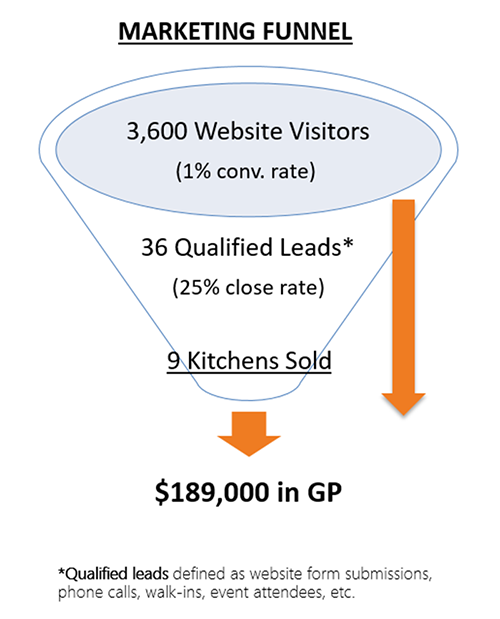9 Elements of an Effective Marketing Plan
There is no short-cutting the most critical part of any marketing campaign — the plan. That’s why this article goes into detail about the nine ingredients every effective marketing plan should have. You’ll gain clarity about each component’s purpose, along with specific examples to crystallize your thinking.
What you’ll gain from this article:
- How to develop the right marketing goals
- How to identify your plan’s truest key performance indicators
- The insights you may be lacking about your target audience(s)
- The difference and relationship between marketing strategy and tactics
- The greatest pitfall when it comes to the marketing budget
Estimated read time = 12 mins
It’s very easy to get distracted and jump right into the weeds. By “weeds,” we mean marketing tactics. Marketers have experienced this far too often. We get a group of colleagues together to develop an annual marketing plan or an upcoming campaign, and folks start blurting out specific ways to go to market. Email marketing. Facebook ads. Publicity. A TV spot. Google ads. Etc.
Please avoid this temptation with all your might. This type of planning is no longer sustainable, especially with today’s marketers being asked to do more than ever. Often with less budget and less staff. We need to be more thoughtful and more measurable with our actions, and a sound marketing plan should be that blueprint. So let’s cover each of these elements in detail:
BUSINESS / ORGANIZATIONAL GOALS
Every organization — for-profit or non-profit, large or small — has goals. Goals give businesses purpose and must have a direct impact on their existence. They come in many forms, including:
- increases in sales revenue
- increases in average order value
- increases in customer lifetime value
- increases in applications and enrollments (colleges and universities)
- increases in fundraising revenue (non-profits)
- increases in the total number of people helped or served (non-profits)
And the list could go on. There are many forms of business goals, and we as marketers have little to no control over how they get created. That said, there’s one key thing we need to remember when creating our marketing plan: Good marketing goals must concretely support business goals. So what should our marketing goals be and how must they support business goals? Read on …
MARKETING GOALS
First, good marketing goals must consist of five key attributes. Many of us have heard about SMART goals, which are:
- Specific
- Measurable
- Assignable
- Realistic
- Time-related
We set ourselves up for failure if even one of these criterion is lacking. SMART goals give us a foundation for holding ourselves accountable, and knowing when we’ve succeeded (or failed). Here are some SMART examples (let’s assume they’re assignable and realistic, too):
- To increase consumer phone calls (leads) by 10% year-over-year between now and June 30
- To increase in-store foot traffic by 5% during Q4 for the NYC store location
- To increase consumer unaided awareness of our brand by 10% within 1 year
- To increase average donation amounts by 10% during November
Next, we fuse our SMART marketing goals with business goals through an activity called Performance Modeling. (Hubspot also refers to this as Smarketing, FYI for you inbound lovers.) A performance model essentially maps the entire consumer journey in a linear progression from the start of campaign promotion to the resulting consumer activity (i.e. leads), and then to actual sales and profitability. Think of the performance model as another way to express the traditional marketing funnel, but with two, key exceptions:
- It gives volume and conversion details for each “micro” conversion of the journey, and
- It reflects sales conversion rates and business goals
Here’s a performance model example for one of our clients offering a high-end kitchen design and installation service:

Performance modeling also offers a framework for future marketing reports at the management/CMO level. It provides crystal clear understanding of which metrics need to be tracked and reported as a campaign progresses. These become our Key Performance Indicators (KPIs). The model essentially becomes a real-time barometer of the campaign’s health and likelihood of reaching its goals. More importantly, it “sounds the alarm” when things are under-performing and prompts much needed campaign adjustments with budget and time still remaining.
And finally, performance modeling gets everyone on board — leadership, marketing and sales. It provides a direct “line of sight” from promotions to profitability, and is easily understood by anyone (not just marketers).
TARGET AUDIENCE(S)
For this blog article, we’ll assume you already know the basics of your target audience. This is usually demographic information such as:
- Age range
- Male/female (or skew toward one of them)
- Countries, regions, and cities and towns in which they live and work
- Annual household income
- Race or ethnicity
- Etc.
That’s a great start, but many marketers overlook the behavioral and psychographic attributes of their target audiences. Some of these are:
- “Mindset” – How do they think about your product or service?
- “Threats” – What would keep them from coming to you?
- economic factors (recession that decreases household spending)
- competitors (with better price points, benefits/features, etc.)
- consumer trends (new ways of thinking that have permanently changed spending habits … think “gluten free”)
- political landscape (new gov’t regulations or election year influences)
- “Habits” – What do they do at each stage of the consumer decision-making process, and what can we do to get in front of them?
The answers to these questions may involve both qualitative (focus groups, interviews, etc.) and quantitative (polls/surveys) research, while some insights could be gained from secondary research (i.e., paying providers like GfK MRI or Nielsen-Scarborough for the data). Either way, the time and investment for these insights will produce a more effective strategy and tactics in the long run.
MESSAGING
Surprisingly, this is an area we see far too many clients lacking in. This is especially painful for sales teams, which are responsible for closing. How can we expect them to convert customers if we don’t equip them with the necessary tools?
Key considerations:
- Establishing the brand position
- Developing a messaging platform to support the brand position (tagline/slogan, elevator pitch, support points/key benefits, competitive differentiation, etc.)
- Understanding how the messaging translates into multiple marketing formats
Bottom line: If we can’t explain the value of what we’re promoting, how can we expect to meet our marketing goals?
It’s very easy to confuse marketing strategy and marketing tactics, so we’ll address these two elements together:
- A strategy is the approach for achieving marketing (and business) goals,
- Tactics are the specific things that execute on the strategy
It’s easiest to think of strategy as “what we need to do” and tactics as “how we’ll get it done”.
Example #1: Old Spice
Business goal: To increase U.S. sales of men’s deodorant by 10% in 12 months
Marketing goal: To increase consumer unaided awareness (by 50%) and favorability (by 20%) of Old Spice deodorant over other brands
Strategy: Target women (wives/girlfriends) because they do the household shopping
One Tactic: Air national TV spots showing an attractive man talking directly to these women … like this …
Example #2: Fictional e-commerce business
Let’s say you sell products through your website. The goal is to increase sales revenue by 15% in 6 months with only a very modest budget.
After much research, you decide that the strategic elements of your marketing plan should be to:
- Increase return visitors to the website
- Increase repeat purchases with current/loyal customers
- Increase the average order value of each checkout
Corresponding tactics for those strategic elements could be:
- Show Google re-marketing ads to customers who viewed specific products, but left without making a purchase
- Email free shipping offers to current customers
- Optimize the checkout process by suggesting complementary products (“you may also like …”) with each item added to the online shopping cart
BUDGET
It is critically important to have a firm and realistic marketing budget. This is a decision that only management — not your marketing department and certainly not your consultant! — can make given how much the organization wishes to invest in future marketing efforts in order to meet its goals.
Businesses too often come to us and say, “Why don’t you tell us how much we should spend?” Or, “We have a zero-based budget … what would you recommend based on our business goals?” The truth is that no marketer or consultant knows how to objectively answer this question. The only way would be an unbelievably perfect scenario of a business knowing their conversion rates for every marketing tactic and how they generated sales for every product or service. (That would be a performance modeling dream, but it is just that.)
The pitfall of this question is the internal marketing team and/or consultant(s) must then needlessly spin their wheels to develop multiple marketing plans for multiple budget scenarios. It’s valuable time and resources wasted. Urge management to give you a firm budget from which to plan. It doesn’t help anyone to develop elaborate marketing plans when there’s only enough money to pay for Google advertising at the end of the day.
TIMING
The marketing plan or campaign’s timing should be influenced by the following:
- The organization’s budget cycle (fiscal year or calendar year)
- Seasonality (holiday shopping season, the Super Bowl, etc.)
- Organizational events (date of a new product launch, store opening, sales promotion, etc.)
A good campaign reflects a timeline to accommodate these circumstances. But a great marketing plan takes it a step further, and projects how it will support sales revenue milestones each month in order to provide cash flow. Here’s an example going back to our kitchen design and installation client. A simple spreadsheet of the performance model is more than sufficient:

ROLES
And finally, no marketing plan will ever meet its goals unless there’s a proper team in place, with each member having clearly defined roles and responsibilities.The best plan in the world is nothing more than ideas unless it can be executed. And it takes the right person or people to do that. There are also great (and cheap) project management tools, like Basecamp or Trello, to keep everyone organized and accountable.





